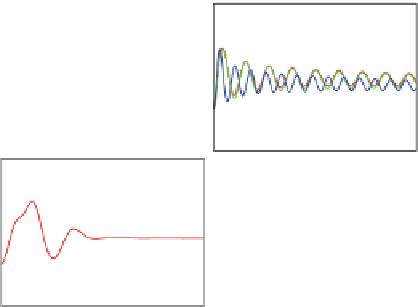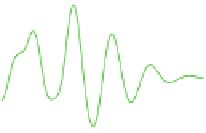Biomedical Engineering Reference
In-Depth Information
a
c
V
B
= 0
V
B
= 0
1.4
1.2
1
0.8
b
d
V
B
= 1 meV
V
B
= 1 meV
1.4
1.2
1
0.8
0
1
2
0
2
4
6
8
τ [ps]
τ [ps]
Fig. 9.20
(
a
)and(
b
) The evolution of the time-integrated signal for short delays without (
a
)and
with (
b
) a biexcitonic shift for
¯
σ
Δ
Δ
(no resonant dots in the ensemble).
Red lines
:
V
=
2meV
and
σ
Δ
=
1meV;
green lines
:
V
=
2 meV and
σ
Δ
=
0
.
5meV;
blue lines
:
V
=
0and
σ
Δ
=
1meV.
comparable with
¯
(
c
)and(
d
)Asin(
a
)and(
b
), respectively, but for
σ
Δ
Δ
.
Red lines
:
V
=
2meV
and
σ
Δ
=
3meV;
green line
:
V
=
2 meV and
σ
Δ
=
5meV;
blue lines
:
V
=
3 meV and
σ
Δ
=
3
meV; and
gray line
:
V
=
0and
σ
Δ
=
3meV[
126
]
whic
h l
eads to quenching of the contributions
F
2
(
t
0
,
τ
)
and
F
3
(
t
0
,
τ
)
at delay times
τ
∼
and thus a decay of the oscillations (Fig.
9.20
a and b). This effect is
a result of the symmetric action of the second exciting pulse which can invert only
the dephasing process induced by the inhomogeneous distribution of the average
transition energies, but not that resulting from the inhomogeneity of the energy
mismatches
in
the ensemble.
If
h
E /
(
Δσ
Δ
)
, then the analyzed sample contains a subensemble of resonant
QDs which have nearly identical fundamental transition energies. The fraction of
identical DQDs emits radiation in phase because the frequency
σ
Δ
∼
Δ
E /
h
has a minimum
at
0, which corresponds to a stationary point of the phase distribution over
the ensemble. Therefore, the signal emitted by these resonant dots may dominate
the contributions
F
2
(
Δ
/
h
=
even, if the subensemble of identical dots
constitutes a minority in the ensemble. As can be seen in Fig.
9.20
c and d, the beats
induced by the resonant DQDs show much slower damping than those originating
from the majority of pairs, but still they vanish on time scales of several picoseconds.
For the resonant subensemble
t
0
,
τ
)
and
F
3
(
t
0
,
τ
)
Δ
∼
0 and thus the frequency of the beats is very
close to 2
V
/
h
or
(
2
V
−
V
B
)
/
h
and does not depend on the energy mismatch. In the
limit of
Δ
→
0 the weight factor
β
−
associated with the frequency
(
2
V
+
V
B
)
/
h
in the formula (
9.36
) vanishes and thus the term with the frequency
h
dominates the response (beats). It is essential because in this way the time-integrated
four-wave mixing signal allows one to characterize the coupling between the dots
and gives the direct access to the properties of the resonant dots even, if they are
only a minority of the investigated ensemble.
(
2
V
−
V
B
)
/


































































































































































